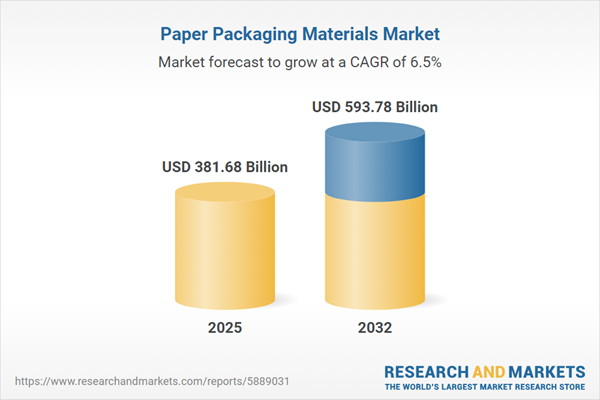Speak directly to the analyst to clarify any post sales queries you may have.
Senior leaders in the paper packaging materials market are contending with shifting regulatory, operational, and sustainability challenges. A successful approach depends on agile strategies that align compliance, efficiency, and environmental objectives—securing long-term business value and supply chain resilience.
Market Snapshot: Paper Packaging Materials Market Overview
The global paper packaging materials market is projected to grow from USD 358.02 billion in 2024 to USD 381.68 billion in 2025, reaching USD 593.78 billion by 2032, with a 6.52% compound annual growth rate. This trajectory is driven by expanding e-commerce, broadening adoption of sustainability practices, and the acceleration of digitalization within the sector. Companies navigating this environment face complex regulatory shifts and broad supply chain demands. Future success in the paper packaging materials market will require harmonizing compliance, technological advancement, and environmental goals—enabling organizations to sustain innovation and cost leadership while safeguarding operational performance.
Scope & Segmentation of the Paper Packaging Materials Market
- Product Types: Corrugated boxes, folding cartons (coated and uncoated), labels, tags, paper bags, sacks, satchels, pouches, kraft, and tissue wrapping support essential functions across food, retail, and industrial sectors, providing protective solutions adaptable to compliance and regulatory needs.
- Material Types: Options include coated papers (clay, poly-coated, dispersed), virgin and recycled kraft grades, glassine, bleached, unbleached, and recycled fibers. Material choice enables companies to meet specific sustainability, compliance, and performance requirements, optimizing products according to varied end-user demands.
- Printing Technologies: Digital, flexographic, gravure, and lithographic printing methods foster rapid prototyping, high-quality personalization, and efficient production, allowing brands to stay responsive to evolving market and regulatory expectations.
- Applications: Use cases span automotive, e-commerce, apparel, electronics, retail, food and beverage, pharmaceuticals, industrial, medical, and personal care packaging. Each application places unique emphasis on compliance, logistics reliability, and consistent customer experience.
- Regions Covered: The Americas, Europe, Middle East & Africa, and Asia-Pacific present distinct market profiles, shaped by local regulations and varying infrastructure maturity. Asia-Pacific stands out for pace of innovation and committed capital investment, influencing overall global demand.
- Company Profiles: Major participants such as International Paper Company, WestRock Company, Smurfit Kappa Group plc, Stora Enso Oyj, Mondi plc, DS Smith Plc, Packaging Corporation of America, Nippon Paper Industries Co., Ltd., Oji Holdings Corporation, and Klabin S.A. demonstrate sector adaptability, continuous innovation, and ongoing investment in research and development.
Key Takeaways for Senior Decision-Makers
- Streamlining packaging operations through digital integration facilitates unified execution and reduces process variability across multiple business units.
- Adopting responsible sourcing and sustainable material practices enhances compliance, meeting regulatory expectations and solidifying trust through transparency along the value chain.
- Utilizing automation and advanced manufacturing supports adaptability, enabling product customization and cost clarity in a competitive resource environment.
- Aligning packaging strategy with e-commerce and omnichannel logistics improves product protection, minimizes risk, and enhances operational agility within diverse distribution networks.
- Adjusting procurement processes according to regional and local regulation strengthens supply chain responsiveness and flexibility amid shifting global policy trends.
- Forming collaborative supplier partnerships mitigates risk and supports business continuity for organizations facing persistent market changes.
Tariff Impact: Navigating U.S. Trade Changes
Forthcoming adjustments to U.S. tariffs on imported paper packaging materials in 2025 present new cost and operational complexities, particularly for firms with global supply networks. In response, companies are diversifying suppliers, boosting domestic capabilities, and investing in adaptive logistics to maintain continuity despite trade policy shifts.
Methodology & Data Sources
This analysis is based on direct executive interviews, in-depth regulatory reviews, continuous monitoring of key industry publications, and proprietary market datasets. Systematic triangulation and advanced modeling techniques yield reliable, actionable results—supporting informed decisions in the paper packaging materials market.
Why This Report Matters
- Supports leadership teams as they benchmark sustainability agendas and digital transformation strategies against industry standards and best practices.
- Provides procurement and supply chain professionals with practical insights to anticipate disruptions, address compliance, and maintain a competitive edge through digital process adoption.
- Advises decision-makers on optimizing sourcing, reducing risk, and fostering adaptive investments to create business value in fluctuating conditions.
Conclusion
Leaders who champion innovation, sustainability, and flexible compliance are positioned to drive operational resilience and market strength as the sector continues to evolve.
Additional Product Information:
- Purchase of this report includes 1 year online access with quarterly updates.
- This report can be updated on request. Please contact our Customer Experience team using the Ask a Question widget on our website.
Table of Contents
3. Executive Summary
4. Market Overview
7. Cumulative Impact of Artificial Intelligence 2025
Companies Mentioned
The companies profiled in this Paper Packaging Materials market report include:- International Paper Company
- WestRock Company
- Smurfit Kappa Group plc
- Stora Enso Oyj
- Mondi plc
- DS Smith Plc
- Packaging Corporation of America
- Nippon Paper Industries Co., Ltd.
- Oji Holdings Corporation
- Klabin S.A.
Table Information
| Report Attribute | Details |
|---|---|
| No. of Pages | 199 |
| Published | October 2025 |
| Forecast Period | 2025 - 2032 |
| Estimated Market Value ( USD | $ 381.68 Billion |
| Forecasted Market Value ( USD | $ 593.78 Billion |
| Compound Annual Growth Rate | 6.5% |
| Regions Covered | Global |
| No. of Companies Mentioned | 11 |









